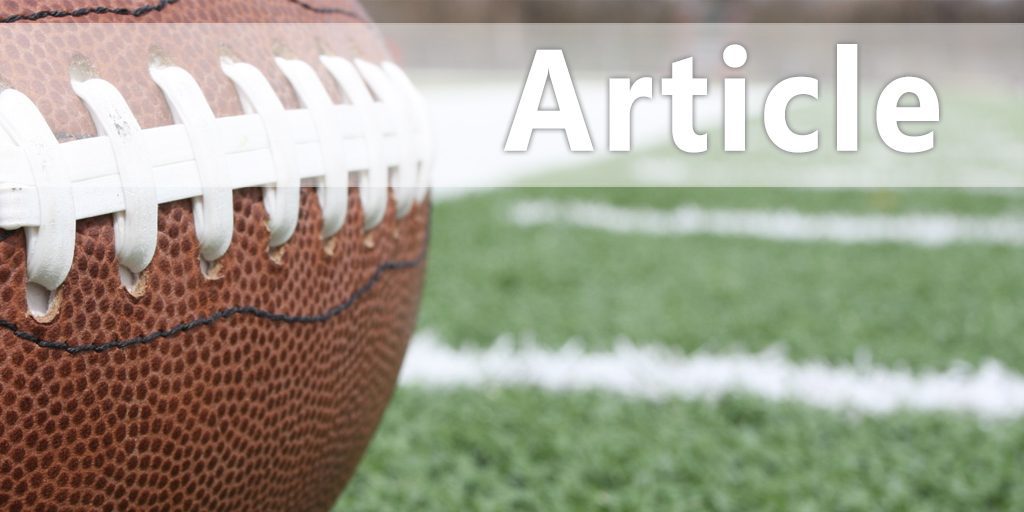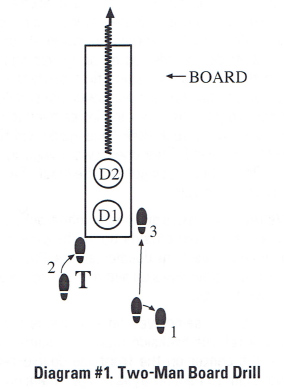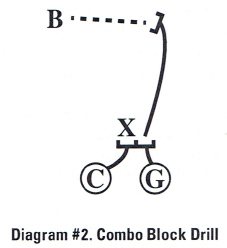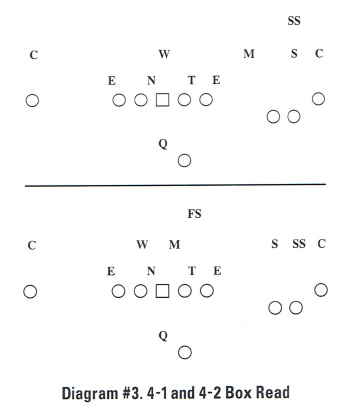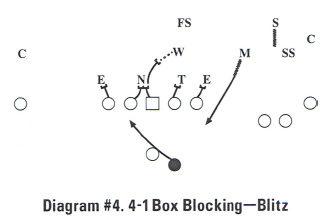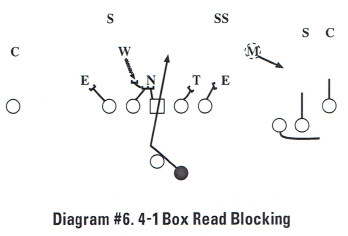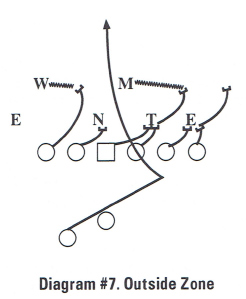| Zone Adjustments: Run and Pass
By Josh Henson – Univ. Of Missouri Originally Published - 2014 C.O.O.L Offensive Line Coaches Handbook - by Earl Browning
Let me show you some of our zone stats for last year. • Ranked 2nd in SEC rushing YPG After the season, when I went back and watched all the cutups, the outside zone had more big plays than the inside zone did. I was thinking we should be running the outside zone play a lot more than we run the inside zone. Why do we run the inside zone? • Double-teams When I call the inside zone, I am looking for double-teams. We used to have one zone play. When I took over as coordinator last year, we went to having an inside zone play and an outside zone play. When we had one zone play, we were always looking for edge pressure and always fanning out the blocking. When I went to the inside zone play, I was looking to get the ball downhill. I wanted to give the offensive linemen the idea that they can come off the ball and double-team the heck out of the defensive down linemen. We were looking to be aggressive. We run it against wide defensive ends. Because we are a spread team, we have open edges a lot. We get defensive ends lined up three or four yards outside of us to try to get a good pass rush. When they get wide, we are going to use the inside zone to attack that. When I say inside zone, for us that means our aiming point is the inside hip of the playside guard, and we are trying to get the back downhill. A lot of teams like to blitz our back. It beats him up in protection. When you hit it quick and can get the cutback in there it can help you beat the edge pressure. The following is our teaching progression: • Two-step contact We work on all of these things every week and incorporate it into our drills. Some of these things we work on every day, one way or another. The first drill is two-step contact. We work simple drills over and over again. I have tape here of half line and 1-on-1 drills. Our aiming point is the inside half of the outside number. We want to be right down the sternum with a little bit of width. If the defender plays wide at the tackle position, we are going to crank the inside hand and be strong with the inside hand and drive it out. We are going to make the back cut and read correctly. Our basic inside zone first and second read is the defensive end to the defensive tackle. We tell our guys to blink the defensive end so if he gets pinched, we can bounce it. In our drill, we are first looking at the lead step. We are going to keep the heel off of the ground on our first step. We want to keep flexion in our ankle and toes. His weight should be on the inside ball of his foot. We want to see him coil his hips and explode through the defensive lineman. With the defender playing wide, we are going to lose a little bit of ground on the first step. On two-step contact, we want to work the second step up the field. We are striking on the second step up the field with our elbows in and thumbs up. We call this the "fit position." We now want to lift the defender and extend our inside hand through his inside number. To finish, we want to get leg drive and drive our feet. Repetition with these drills is important. We are looking for contact on the second step with our thumbs up. We focus on shooting our hands and keeping our eyes back. These are not at full speed. We want the focus to be on the fit. One point to watch for is we do not want his hips to come up when he takes the first steps out of his stance. We want to see them coiled so he can gain leverage and gain position. We carry the drill to the sled. It is a little bit tougher on a five-man sled to move it. Now that we have worked our two steps, we now want to work our fit progression. We call this our fit and roll drill. We work for a fit position and want to focus on the lift and rolling our hips at the second step. We are pressing our hands and rolling our hips. The next progression is the fit and drive. It is basically the same thing, and now as we drive, we are concentrating on staying in a fit position. If we get into a leaning position, he is going to get jerked around or thrown down. The blocker must engage the defender's core by lifting his arms, staying in a fit position, and driving his legs. We can run this drill with a half line. One of my favorite things to do is have the defender try to move the offensive blocker one side or another and to knock their hands off so we have to reengage. We have to go 1-on-1 when we do that so we are not running into each other and getting people rolled up on. The next progression is the leg drive. We work on this all of the time. We use basic drills like working the boards to see leg drive and finish. We want to overemphasize leg drive and finish. We will work on it on the sleds, looking for lift and leg drive. Probably our favorite drill is the two-man board Drill. It works out that we have to practice on our game field a lot. We do not have room for our sled there. This is a way we have worked out that replaces our sled. We have found it to be a little more realistic. We essentially have two guys replace the sled. The first guy is there for the lift, just like you do with the sled. The second guy is directly behind the first guy with his hands on his back to simulate the weight of the sled (Diagram #1).
We are looking for the proper steps. We are looking for the lift and roll of the hips. At the snap, the blocker fits and lifts the defender off the ground. Applying resistance, the second defender keeps the first guy in the air as the blocker moves his feet. If the blocker disengages, the first guy will land on the ground because the second defender is applying the resistance. It forces the blocker to drop his hips again, drop his hands, and drive back through. This is the way we get our sled work done. From working on our single blocks, we go to double-teams. In this drill, we are working on our combination blocks with a down lineman and a linebacker (Diagram #2). This is 2-on-2.
Again, we are looking at the first steps. We want contact on the second step. I want our outside guy on a double-team versus an inside shade to lower his inside shoulder as he brings his second step up the field. He is making first contact with the top of his shoulder. As we lower the shoulder, I teach those guys to take their inside hand that is making contact to tuck their hand inside and then lift with that hand. This does two things in my opinion. One, it helps you get off the block. Two, it helps to stabilize you. We teach our inside guy on a combo block to put his eyes right on the outside tip of the defender's shoulder pads where the double-team is. Obviously, we need to get our eyes up and find the linebacker we are working to. We drill the same way on a backside combo block. We tell the backside tackle the same thing we tell the center on the frontside double-team. We want him to take his eyes and put them on the tip of the defender's shoulder pad and drive his eyes through the block. We practice the things we are going to do in the game and we do it over and over and over again. Next, we go into our backside cutoff blocking, We will be singled up a lot with the backside guys. The two backside guys basically use the same technique as the guard would do on a backside double-team. If the defender tries to cross our face, we will bring the second hand into it and make it a two-handed block. Again, we are looking for the second step to be up the field with contact and lift. Inside Zone Base Rules • Identify 4 down vs. 3 down Let me get more into the inside zone play. The quarterback is going to be at five yards. Our running back is going to be at five and a half to six: If we tell him six, he likes to scoot up and get closer to the quarterback. On the inside zone, the quarterback is going to take the ball and step to the playside at a 45-degree angle. He will turn his hips and close the back off and send him downhill into the frontside A-gap. So we do not tip off the outside zone with alignment, we align in the same position. The quarterback would then step straight back with his first step. The running back's aim point is the inside hip of the guard. We want him to take a 45-degree angle step downhill. The lead step is with the front foot. He is blinking the outside defender, but he is riding the frontside down lineman and making his cut from there. We are always playing off of a 4-1 box read or a 4-2 box read when we call our inside zone play (Diagram #3). When we are in a 4-1 box read, we are going to be reading the Mike linebacker. The quarterback is reading the Mike linebacker, and we will have a quick game call. It might be bubble screen, a now screen, or whatever. Our guys know the first spot past is outside the box. We will be working the backside cutoff technique with our linemen. If the Mike comes running in, we are going to flip it out to the outside guys. If the Mike lines up tight, the quarterback can still flip it out, pre-snap.
I get asked if we do it pre-snap or post-snap. We do it both ways. Sometimes, you will see him catch the ball, turn, and just throw it. Sometimes, you will see him catch the ball, he reads the Mike, and if he is running in, he flips his hips and throws the bubble or whatever quick game call we have made. From a 4-2 box, if we have a full zone play called, the Will is the Mike. We are doubling on the first spot past the guards. The quarterback read becomes the defensive end. Those are the basics of what we do. We do have some plays where we are staying big on the backside no matter what. If the quarterback read is already in the box, it is telling him he is throwing it right now. Usually when we do that, we call a quick game with it. I know you are thinking, you are calling quick game and running game, both? Yes! It works out pretty good for us. The quarterback knows that if the defense blitzes off the backside, he isn't protected. He is going to read the man blitzing and hand the ball off (Diagram #4). (Film)
The left tackle knows he is manned up. He is striking with the inside hand underneath with his elbows tight. We are looking for him to lift, engage the defensive ends core, and move his feet. The left guard and center are double-teaming the 3 technique and the Will linebacker. You will see the center puts two hands on the down noseguard and he gets turned to the outside. I do not want to see that. He should lift with the inside hand and keep his eyes on the linebacker. He has his hips turned to the outside when the man he is to climb to is inside. He is making life hard on himself. Next, we have a 4-2 box look (Diagram #5). The quarterback has identified the Mike and sees a 4-2 box and knows his read is the defensive end. He is looking from the top down. He sees three over three to the trips side.
The left tackle should step with his outside foot. If that guy plays wide, we are going to crank our hand and create space by driving him laterally. The left guard and center work their double-team to the linebacker. We harp on driving and getting movement. The right guard and right tackle combo the defensive tackle and Will linebacker. Let's look at another 4-1 box (Diagram #6). In a 4-1 box, the quarterback's read is outside the box. We are going to be working through the defensive end. This is a bubble screen. Our read is moving away from the run to help with the screen so we are going to hand the ball off.
I want to talk about tempo on the zone play. Why We Use Tempo • To create an advantage Using an uptempo has been a huge advantage for us this year. It has especially been an advantage against teams whose personnel are really good. We practice fast all of the time, and we tell our guys by the end of the game the defense is going to be dragging. I would say about 60 percent of our practice, we are going really fast. We want to wear down our opponent. If you are going fast, the defense will only have two or three different calls they can make. You can figure out what those are early in the game and make adjustments to just those few calls. Our Tempos • NASCAR - No-Huddle: Any formation, any play, quick tempo Our base tempo is NASCAR. We are in a hurry, but we are not sprinting. We can call any formation and any play. We are hustling to the line of scrimmage. When we give the speed signal, that means whatever formation we were just in, line up in that formation just as fast as you can. We can look, or we can call a different play. We are sprinting to get into that formation, then they get the play, and boom off we go. We try to condense our play calls into one, two, or three words as much as possible. If we call lap, we are going to take another lap. We are going to run the same play again. Line up and run it as fast as we can. Carl Edwards is a NASCAR driver from Columbia, Missouri. When we go Carl, we will have some checks in by game planning. It is just like speed, but the quarterback will have one or two plays he can call based on the defense and game planning. If the quarterback can handle it, I like that. It is better than looking over to the sideline because the defense can change while he is getting the signal. When we put it into the quarterback's hands, they do not change as much. Pit for us is just huddle up. We will huddle especially if we are ahead or trying to run some clock. Not only are we able to run plays while the defense is turned around trying to tell each other how to line up and end up with a free six-, seven-, or eight-yard run, it is also frustrating to the defense. Our guys start laughing because the defense is yelling at each other. Our guys feed off that. Sometimes, I do not want to go fast and they come to me saying keep going faster and faster. Our kids have really bought into it and really like it. Before I get through, let me show you some adjustments to the 4-2 box: • Identify run support player You are probably saying all that stuff is great if the defense is in two high zone and you are reading the Mike. These are just some of the things we do. Identify the run support player. He is already in the box. Having a quick game and throwing the football off of it is helpful. Our Adjustments to a 4-2 Box • Stretch To me, running the stretch out of the gun is probably the most forgiving play you can run. Plays that probably shouldn't work can turn into a 10-yard gain if you just keep working the block. You don't have to get a great block, but you have to keep working it. I believe having the combination of both the inside zone and the outside zone gives our linemen another tool. With the inside zone, we are pounding and pounding away. The defense is firing off the ball, trying to get penetration up the field straight ahead. Our change-up is the outside zone. We are reaching them and running around them. It gives our linemen another weapon. If we get teams that are going to overload the box by putting everybody in the box with a single high safety, then we are going to run outside zone. The quarterback is going to catch the ball and step straight back. The aiming point for the running back is the butt of the tight end. He is reading one to two, the defensive end to defensive tackle. We tell him that by the time he gets the ball, he should already know what the first read is doing. As he is riding it, he should be reading #2. Can he hit it up in the B gap, can he get around it, or does he need to cut it back?
Let me show you the outside zone(Diagram #7). I am probably a little different in that we are blocking it a lot like inside zone. The center is going to bring his nose to the tip of the defensive tackle's shoulder pad. It is the same for the tackle and tight end. We are trying to work combinations and get around the edge. On the backside, we are doing the same thing. If we get the defender reached, we want to drive our eyes straight up the field. We do not want to turn him back because we have found they can fight off the block and get over top of you and back into the play. What could have been a 20-yard gain turns into a four-yard gain. If the defender is fighting hard down the line of scrimmage, we are going three to five steps with him and then we are chopping him. Guys, I hope you got something out of this. I thank you for your time.
Josh Henson joined the University of Missouri football coaching staff in February 2009, and was promoted to offensive coordinator following the 2012 season. The first new hire to join Gary Pinkel's staff since he came to Missouri in 2001, Henson came aboard to serve as co-offensive line coach. Six of his offensive line pupils at MU have won all-star honors nine times in his tenure, including the most recent being true freshman guard Evan Boehm, who was named a First-Team Freshman All-American by College Football News following the recently completed season. Missouri offensive line helped pave the way to a conference team rushing title in 2011 (ranking 9th nationally), and also to a final national rank of 12th in total offense (475.54 YPG). Henson has provided an immediate impact for the Tigers' football program, both on and off the field. The Tigers' offensive line - despite the pre-season loss of All-Big 12 left tackle Elvis Fisher to a season-ending injury - developed into a stout unit that paved the way for a Big 12 team rushing title in 2011. The Tigers ranked 9th nationally, and led the Big 12 in rushing (244.00 avg.) and also ranked 12th nationally in total offense (475.54 avg.), despite featuring a first-year starter at quarterback. In the recruiting battles, Henson quickly helped MU establish ties to areas in which it had little success in recent years, and his efforts helped the Tigers' 2010 class to a No. 21 national ranking by Rivals.com - marking the highest ranking ever for an MU recruiting class. Henson replaced former Tigers' coach Dave Christensen, who was the first assistant to leave Pinkel's staff since coming to MU in 2001. Christensen was named the head coach at Wyoming in December 2008. Henson spent his four years prior to joining Missouri as tight ends coach and recruiting coordinator at Louisiana State University, where he developed the reputation as being a tremendous on-field teacher of the game, while also leading the charge for LSU's recruiting classes which ranked among the top 10 in the nation four times - including a 2009 class which ranked as No. 2 in the nation according to Rivals.com. A former standout offensive lineman at Oklahoma State University, Henson spent 10 years as a player and coach at the university. In 2007, Henson's coaching efforts helped LSU sophomore tight end Richard Dickson put together one of the most productive seasons at the position in school history. At Oklahoma State, Henson was instrumental in the development of Billy Bajema, who was a three-year starter for the Cowboys. As a senior in 2004, Bajema was one of the top tight ends in the country, earning first-team All-Big 12 honors. Bajema was picked in the seventh round of the 2004 NFL Draft by the San Francisco 49ers. As a player, Henson was a four-year letter-winner with 40 career starts for Oklahoma State from 1993-97. He was a starter on the offensive line as well as team captain for Oklahoma State's 8-4 team in 1997, a squad that played in the Alamo Bowl against Purdue. He was a second-team All-Big 12 selection as a senior. In addition to being an honorable mention All-Big 12 pick as a junior. Off the field, Henson was named the recipient of the L.L. Boger Award as a senior, an honor that recognizes a student-athlete's achievement both on the field and in the classroom. Henson graduated from Oklahoma State with a bachelor's degree in secondary education in 1998. Upon graduation, he went straight into coaching, serving as a high school football coach in Kingfisher, Oklahoma. In one season at Kingfisher, he helped guide the Yellowjackets to the state semifinals. Henson returned to Oklahoma State as a graduate assistant in July of 1999, spending one year with the Cowboy offensive line before taking a full-time position with OSU as tight ends coach in 2001. Henson is a native of Tuttle, Oklahoma. He and his wife Shauna have an 8-year-old son, Will, and a 4-year-old daughter, Kate, Henson lists golf, fishing, and hunting as his hobbies in his spare time.
|
